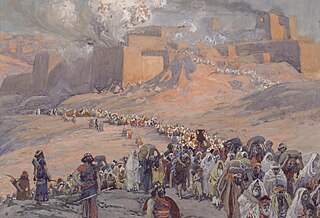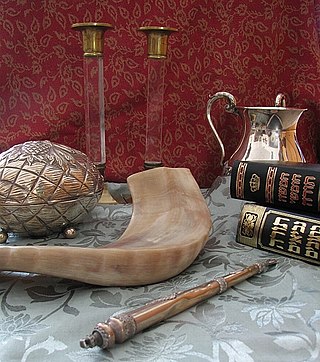The Book of Chronicles is a book in the Hebrew Bible, found as two books in the Christian Old Testament. Chronicles is the final book of the Hebrew Bible, concluding the third section of the Jewish Tanakh, the Ketuvim ("Writings"). It contains a genealogy starting with Adam and a history of ancient Judah and Israel up to the Edict of Cyrus in 539 BC.

The Book of Nehemiah in the Hebrew Bible, largely takes the form of a first-person memoir by Nehemiah, a Jew who is a high official at the Persian court, concerning the rebuilding of the walls of Jerusalem after the Babylonian exile and the dedication of the city and its people to God's laws (Torah).

Ezra or Esdras, also called Ezra the Scribe in Chazalic literature and Ezra the Priest, was an important Jewish scribe (sofer) and priest (kohen) in the early Second Temple period. In Greco-Latin Ezra is called Esdras. His name is probably a shortened Aramaic translation of the Hebrew name עזריהו Azaryahu, "Yah helps". In the Greek Septuagint the name is rendered Ésdrās, from which the Latin name Esdras comes.

The history of ancient Israel and Judah covers the history of the Israelite tribes from their appearance in new villages in the hill country of Canaan, through the existence of the kingdoms of Israel in the north and Judah in the south, and up to the demise of those kingdoms at the hands of the Mesopotamian empires. It plays out in Southern Levant during the Iron Age. The earliest known reference to "Israel" as a people or tribal confederation is in the Merneptah Stele, an inscription from ancient Egypt that dates to about 1208 BCE. According to modern archaeology, ancient Israelite culture developed as an outgrowth from the preexisting Canaanite civilization. Two related Israelite polities known as the Kingdom of Israel and the Kingdom of Judah had emerged in the region by Iron Age II.

The Israelites were a group of Semitic-speaking tribes in the ancient Near East who, during the Iron Age, inhabited a part of Canaan.

The Babylonian captivity or Babylonian exile is the period in Jewish history during which a large number of Judeans from the ancient Kingdom of Judah were captives in Babylon, the capital city of the Neo-Babylonian Empire, following their defeat in the Jewish–Babylonian War and the destruction of Solomon's Temple in Jerusalem. The event is known to be historical, and is described in archaeological and extra-biblical sources, in addition to the Hebrew Bible.
The Ketuvim is the third and final section of the Tanakh, after Torah ("instruction") and Nevi'im ("prophets"). In English translations of the Hebrew Bible, this section is usually titled "Writings" or "Hagiographa".
1 Esdras, also Esdras A, Greek Esdras, Greek Ezra, or 3 Esdras, is the ancient Greek Septuagint version of the biblical Book of Ezra in use within the early church, and among many modern Christians with varying degrees of canonicity. 1 Esdras is substantially similar to the standard Hebrew version of Ezra–Nehemiah, with the passages specific to the career of Nehemiah removed or re-attributed to Ezra, and some additional material.

Nehemiah is the central figure of the Book of Nehemiah, which describes his work in rebuilding Jerusalem during the Second Temple period. He was governor of Persian Judea under Artaxerxes I of Persia.
Ezra–Nehemiah is a book in the Hebrew Bible found in the Ketuvim section, originally with the Hebrew title of Ezra. The book covers the period from the fall of Babylon in 539 BCE to the second half of the 5th century BCE, and tells of the successive missions to Jerusalem of Zerubbabel, Ezra, and Nehemiah, and their efforts to restore the worship of the God of Israel and to create a purified Jewish community. It is the only part of the Bible that narrates the Persian period of biblical history.
Gerald "Gary" Neil Knoppers was a professor in the Department of Theology at University of Notre Dame. He wrote books and articles regarding a range of Old Testament and ancient Near Eastern topics. He is particularly renowned for his work on 1 Chronicles, writing I Chronicles 1 – 9 and I Chronicles 10 – 29, which together comprise a significant treatment of the work of the Chronicler. In May 2005 the Canadian Society of Biblical Studies/Societe canadienne des Etudes bibliques granted the R. B. Y. Scott Award to Knoppers for his two-volume Anchor Bible commentary on I Chronicles

The origins of Judaism lie in Bronze Age polytheistic Canaanite religion. Judaism also syncretized elements of other Semitic religions such as Babylonian religion, which is reflected in the early prophetic books of the Hebrew Bible.

Yehud Medinata, also called Yehud Medinta or simply Yehud, was an autonomous administrative division of the Achaemenid Persian Empire. It constituted a part of Eber-Nari and was bounded by Arabia to the south, lying along the frontier of the two satrapies. Spanning most of Judea—from the Shephelah in the west to the Dead Sea in the east—it was one of several Persian provinces in Palestine, together with Moab, Ammon, Gilead, Samaria, Ashdod, and Idumea, among others. It existed for just over two centuries before the Greek conquest of Persia resulted in it being incorporated into the Hellenistic empires.
David McLain Carr is Professor of Old Testament at the Union Theological Seminary in New York City. He is a leading scholar of the textual formation of the Hebrew Bible.
Hugh Godfrey Maturin Williamson is a theologian and academic. He was Regius Professor of Hebrew at the University of Oxford from 1992 to 2014, a position he now holds as Emeritus.
David John Alfred Clines was a biblical scholar. He served as professor at the University of Sheffield.
Carol Ann Newsom is an American biblical scholar, historian of ancient Judaism, and literary critic. She is the Charles Howard Candler Professor Emerita of Old Testament at the Candler School of Theology and a former senior fellow at the Center for the Study of Law and Religion at Emory University. She is a leading expert on the Dead Sea Scrolls, Wisdom literature, and the Book of Daniel.
Daniel Edward Fleming is an American biblical scholar and Assyriologist whose work centers on Hebrew Bible interpretation and cultural history, ancient Syria, Emar, ancient religion, and the interplay of ancient Near Eastern societies. Since 1990, he has served as a professor of Hebrew Bible and Ancient Near Eastern Studies in the Skirball Department of Hebrew and Judaic Studies at New York University, where he has spent his whole career.

Ezra 1 is the first chapter of the Book of Ezra in the Old Testament of the Christian Bible, or the book of Ezra–Nehemiah in the Hebrew Bible, which treats the book of Ezra and book of Nehemiah as one book. Jewish tradition states that Ezra is the author of Ezra–Nehemiah as well as the Book of Chronicles, but modern scholars generally believe that a compiler from the 5th century BCE is the final author of these books.
Ehud Ben Zvi is a historian of ancient Israel with a focus on the Achaemenid period and a scholar of the Hebrew Bible with a focus on Social Memory. He is Professor Emeritus in the Department of History, Classics and Religion at the University of Alberta.









